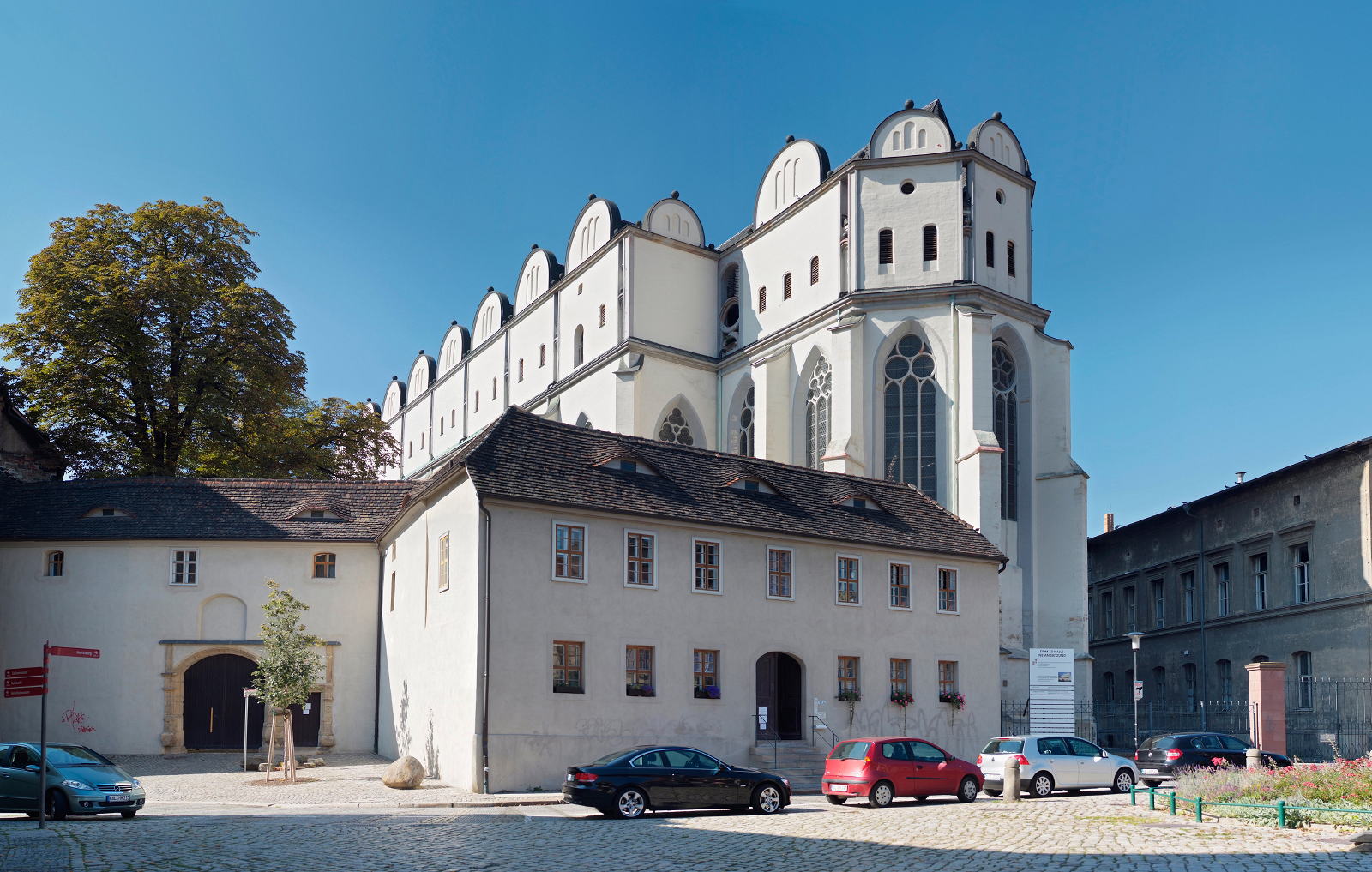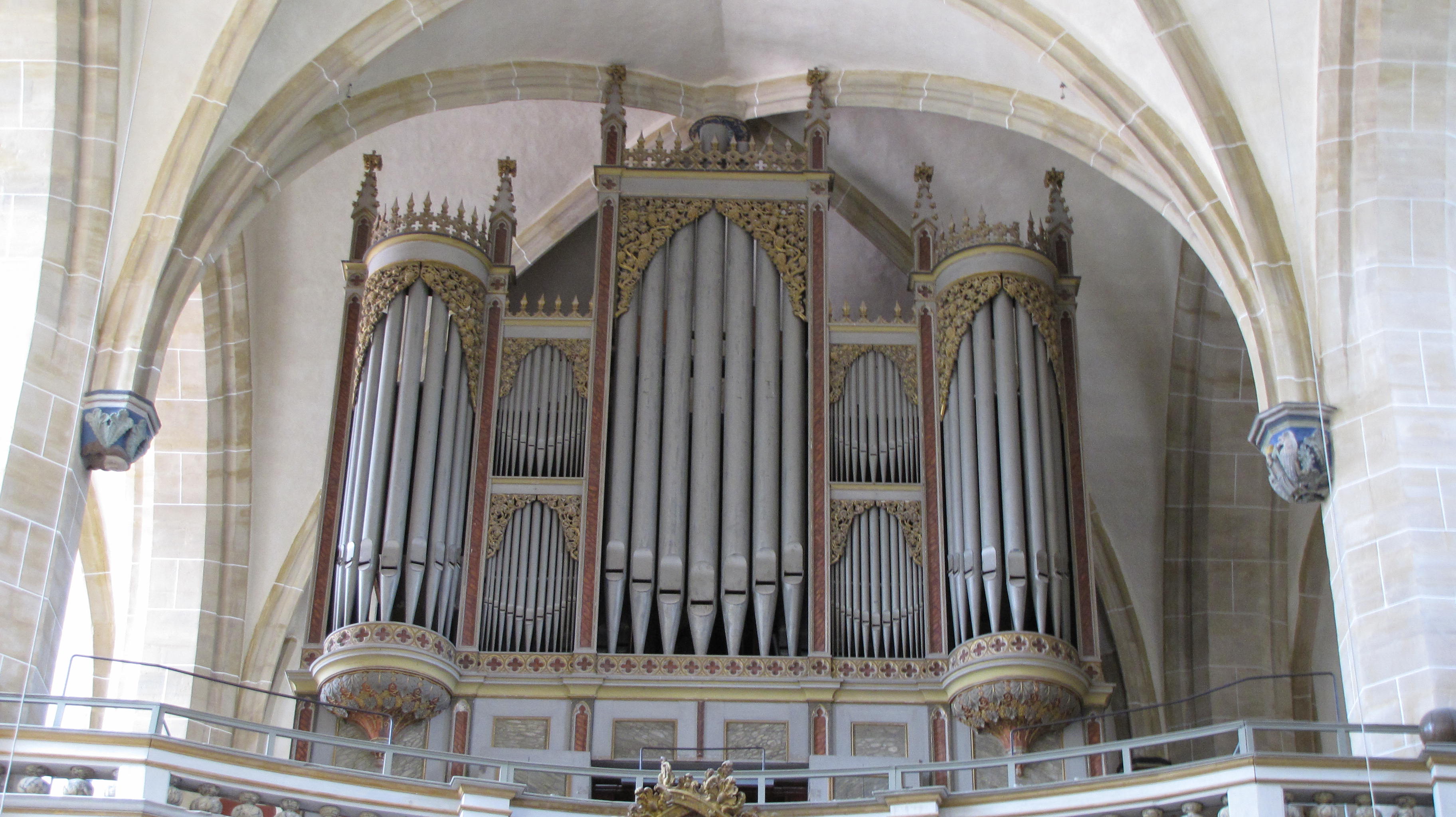Halle Cathedral on:
[Wikipedia]
[Google]
[Amazon]

 Halle Cathedral (german: Dom zu Halle, link=no) is the oldest surviving church in the old part of the city Halle, Saale. Beside it resided the
Halle Cathedral (german: Dom zu Halle, link=no) is the oldest surviving church in the old part of the city Halle, Saale. Beside it resided the
''The Meeting of St Erasmus and St Maurice''
from
 In 1851 the parish replaced the church's baroque organ with a new instrument built by Friedrich Wilhelm Wäldner and August Ferdinand Wäldner, who had begun work on the instrument four years earlier. This instrument was used by a young
In 1851 the parish replaced the church's baroque organ with a new instrument built by Friedrich Wilhelm Wäldner and August Ferdinand Wäldner, who had begun work on the instrument four years earlier. This instrument was used by a young
Official website
Der Dom zu Halle (dome-schloesser.de)
''Halle / Dom (1851)'' - organ article
{{Coord, 51.4843, 11.9645, type:landmark_region:DE, display=title, format=dms Churches in Saxony-Anhalt Gothic hall churches in Germany

 Halle Cathedral (german: Dom zu Halle, link=no) is the oldest surviving church in the old part of the city Halle, Saale. Beside it resided the
Halle Cathedral (german: Dom zu Halle, link=no) is the oldest surviving church in the old part of the city Halle, Saale. Beside it resided the Archbishop of Magdeburg
The Archbishopric of Magdeburg was a Roman Catholic archdiocese (969–1552) and Prince-Archbishopric (1180–1680) of the Holy Roman Empire centered on the city of Magdeburg on the Elbe River.
Planned since 955 and established in 968, the Roman ...
, who ruled the city for a long period. Albert of Brandenburg
Cardinal Albert of Brandenburg (german: Albrecht von Brandenburg; 28 June 149024 September 1545) was a German cardinal, elector, Archbishop of Mainz from 1514 to 1545, and Archbishop of Magdeburg from 1513 to 1545.
Biography Early career
Bo ...
remodelled the church's exterior from 1520 onwards and built the neighbouring Neue Residenz, aiming to make the church one of the most influential and powerful monasteries north of the Alps.
History
It was founded as a Dominican monastery in 1271 and completed in 1330, with a simple three-aisle abbey church dedicated to ''Sankt Paul zum heiligen Kreuz'' (the order's rules prohibited a tower or a separate choir). Around 1520 the then-archbishopAlbert of Brandenburg
Cardinal Albert of Brandenburg (german: Albrecht von Brandenburg; 28 June 149024 September 1545) was a German cardinal, elector, Archbishop of Mainz from 1514 to 1545, and Archbishop of Magdeburg from 1513 to 1545.
Biography Early career
Bo ...
had Bastian Binder remodel the church's exterior, adding rounded gables. It was reconsecrated in 1523 as the Stiftskirche of the Archdiocese. It was probably first referred to as a 'Dom' or cathedral at that time, although it was never the seat of the archbishopric. From 1523 onwards Albert also took on artists to improve the interior, commissionin''The Meeting of St Erasmus and St Maurice''
from
Matthias Grünewald
Matthias Grünewald ( – 31 August 1528) was a German Renaissance painter of religious works who ignored Renaissance classicism to continue the style of late medieval Central European art into the 16th century. His first name is also given ...
, altarpieces from Lucas Cranach the Elder
Lucas Cranach the Elder (german: Lucas Cranach der Ältere ; – 16 October 1553) was a German Renaissance painter and printmaker in woodcut and engraving. He was court painter to the Electors of Saxony for most of his career, and is know ...
and stone sculptures by Peter Schro. Between 1519 and 1525 Cranach and his workshop produced 16 altarpieces for the church with a total of 140 panels, though only two central panels, some wings and a few sketches survive. These alterations led to a church whose overall appearance was late Gothic and early Renaissance, an outstanding work of the Saxon Renaissance
The Saxon Renaissance (in German: ''Sächsische Renaissance'') is a regional type of architecture from the Renaissance particularly in the area of the Electorate of Saxony on the middle Elbe. Influences that formed the style came primarily from ...
.
As an opponent of Martin Luther
Martin Luther (; ; 10 November 1483 – 18 February 1546) was a German priest, theologian, author, hymnwriter, and professor, and Order of Saint Augustine, Augustinian friar. He is the seminal figure of the Reformation, Protestant Refo ...
, Albert was forced out of Halle in 1541 and took the church's portable fittings with him to Aschaffenburg
Aschaffenburg (; South Franconian: ''Aschebersch'') is a town in northwest Bavaria, Germany. The town of Aschaffenburg is not part of the district of Aschaffenburg, but is its administrative seat.
Aschaffenburg belonged to the Archbishopric ...
, where they remain. His secular successors as rulers of the area used the church as a chapel for their court and palace. The last such ruler, Augustus, Duke of Saxe-Weissenfels
Augustus of Saxe-Weissenfels (Dresden, 13 August 1614 – 4 June 1680, Halle), was a Duke of Saxe-Weissenfels-Querfurt of the House of Wettin and administrator of the Archbishopric of Magdeburg.
He was the fourth (but second surviving) son of J ...
, added galleries and a larger altar in the mid 17th century, altering the church's style to early Baroque. In 1680 Frederick William, Elector of Brandenburg
Frederick William (german: Friedrich Wilhelm; 16 February 1620 – 29 April 1688) was Elector of Brandenburg and Duke of Prussia, thus ruler of Brandenburg-Prussia, from 1640 until his death in 1688. A member of the House of Hohenzollern, he is ...
made it a parish church (by then the area was Protestant-Reformed) and in 1702 a young Georg Friedrich Händel
George Frideric (or Frederick) Handel (; baptised , ; 23 February 1685 – 14 April 1759) was a German-British Baroque composer well known for his operas, oratorios, anthems, concerti grossi, and organ concertos. Handel received his training ...
was employed there for a year's probationary period.
The first abbess of the 'Freiweltliches adeliges von Jena’sches Fräuleinstift' was appointed in the church in 1703, the order having been founded by Gottfried von Jena with royal Prussian approval the previous year. The abbesses were also buried in the church. The interior was 're-Gothicised' between 1883 and 1896 and the outer walls and interior were restored by the Denkmalpflege between 1957 and 1959. The Domstiftung Sachsen-Anhalt began a full renovation of the church in 1996, with work largely completed by 2005.
Description
Organs
Main organ
George Frideric Handel
George Frideric (or Frederick) Handel (; baptised , ; 23 February 1685 – 14 April 1759) was a German-British Baroque music, Baroque composer well known for his opera#Baroque era, operas, oratorios, anthems, concerto grosso, concerti grossi, ...
shortly after beginning his education at University of Halle
Martin Luther University of Halle-Wittenberg (german: Martin-Luther-Universität Halle-Wittenberg), also referred to as MLU, is a public, research-oriented university in the cities of Halle and Wittenberg and the largest and oldest university i ...
.
Choir organ
Bibliography (in German)
* Heinrich L. Nickel: ''Der Dom zu Halle.'' Schnell und Steiner, München u. Zürich 1991. Ohne ISBN. * Holger Brülls / Thomas Dietsch: ''Architekturführer Halle an der Saale.'' Dietrich Reimer, Berlin 2000, . * Achim Todenhöfer: ''Steinernes Gotteslob. Die mittelalterlichen Kirchen der Stadt Halle.'' In: ''Geschichte der Stadt Halle, Bd. 1, Halle im Mittelalter und der Frühen Neuzeit.'' Mitteldeutscher Verlag, Halle 2006, . S. 207–226. * Peggy Grötschel / Matthias Behne: ''Die Kirchen der Stadt Halle''. Mitteldeutscher Verlag, Halle 2006, . * Martin Filitz: ''Halle Dom.'' Schnell und Steiner, Regensburg 2006, . * Ellen Horstup: ''Halle Dom.'' In: Christian Antz (editor): ''Sieben Dome. Architektur und Kunst mittelalterlicher Kathedralen.'' Verlag Janos Stekovics, Dößel 2009, , Seite 188–213. * Achim Todenhöfer: ''Kirchen der Bettelorden. Die Baukunst der Dominikaner und Franziskaner in Sachsen-Anhalt''. Dietrich Reimer Verlag, Berlin 2010, . S. 81–91. * Matthias Hamann: ''Der Liber Ordinarius Hallensis 1532. (Staatsbibliothek Bamberg, Msc. Lit. 119). Liturgische Reformen am Neuen Stift in Halle an der Saale unter Albrecht Kardinal von Brandenburg'' (Jerusalemer Theologisches Forum 27). Aschendorff, Münster 2014. .References
External links
Official website
Der Dom zu Halle (dome-schloesser.de)
''Halle / Dom (1851)'' - organ article
{{Coord, 51.4843, 11.9645, type:landmark_region:DE, display=title, format=dms Churches in Saxony-Anhalt Gothic hall churches in Germany